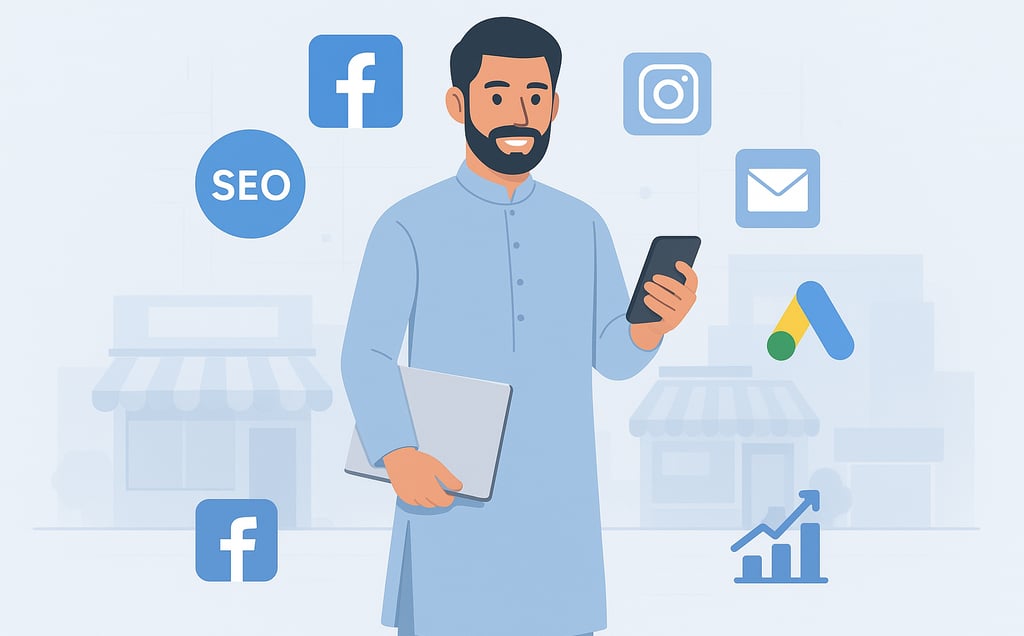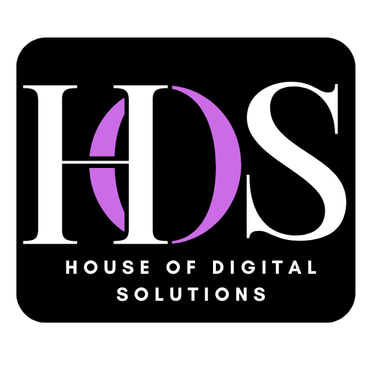Digital Marketing: for Pakistani Small Businesses
Running a small business in Pakistan today is no easy feat. Costs are rising, competition is fierce, and customer behavior has shifted online. Flyers and word of mouth aren’t enough anymore—if your business isn’t visible digitally, you’re already missing out. In this guide, we break down the core strategies every small business owner in Pakistan should know, common mistakes to avoid, and a step-by-step roadmap to get started.
ONLINE PRESENCE
8/18/20256 min read


Introduction
Running a small business in Pakistan is no easy job. Between rising costs, tough competition, and changing customer behavior, staying ahead can feel overwhelming. In today’s world, traditional marketing methods like flyers, print ads, and word of mouth are no longer enough. Customers are online, and if your business isn’t visible there, you’re already losing opportunities.
This is where digital marketing comes in. The good news? It’s not as complicated (or expensive) as many small business owners think. With the right strategies, even a small shop in Karachi or a startup in Lahore can use digital tools to attract customers, build credibility, and grow steadily.
What is Digital Marketing?
At its core, digital marketing is simply using the internet and digital platforms to connect with customers. It could be as simple as running a Facebook page for your bakery, or as advanced as setting up an e-commerce website for your clothing brand.
In Pakistan, where over 130 million people use smartphones, digital marketing isn’t just a trend—it’s the new way of doing business.
Why Pakistani Small Businesses Need Digital Marketing
Here are three big reasons small businesses can’t afford to ignore the digital world:
Cost-Effective Reach – Unlike TV or billboard ads, digital marketing allows you to reach thousands of people with just a fraction of the budget.
Customer Habits Have Changed – People search Google for “restaurants near me” or scroll Instagram for fashion trends before making decisions. If you’re not online, they won’t find you.
Competition is Online – Whether it’s clothing stores, restaurants, or real estate agencies—most competitors already have a digital presence. Falling behind can cost you customers.
The Core Components Every Small Business Should Know
1. Social Media Marketing
In today’s digital age, social media is not
just about posting pictures or videos—
it’s about building connections and
communities. Platforms like Facebook,
Instagram, and TikTok are where people
spend a large portion of their day,
making them the perfect spaces for
small businesses to reach potential
customers. Social media marketing
allows you to create a brand personality,
interact directly with your audience, and
showcase your products or services in
creative ways.
For example, a clothing boutique in Karachi can post Instagram reels showing styling tips for Eid outfits, while a café in Lahore can share behind-the-scenes TikTok clips of their chefs preparing signature dishes. Story features, live sessions, and polls encourage interaction and make customers feel involved with your brand. The biggest advantage? It’s cost-effective. Unlike traditional advertising methods such as TV or print ads, social media gives you organic reach without heavy investment—especially when content is engaging, shareable, and relatable.
Additionally, the targeting capabilities of these platforms are unmatched. Through paid promotions, you can reach exactly the type of customers who are most likely to buy—be it based on location, age, gender, or interests. A startup gym in Islamabad, for instance, can run ads targeting people interested in fitness within a 5-kilometer radius. When done consistently, social media marketing helps businesses build trust, stay top of mind, and turn casual scrollers into loyal customers. For small businesses, this is no longer optional—it’s a must-have strategy to grow in a competitive market.
2. Search Engine Optimization (SEO)
Imagine someone in Karachi typing “best
biryani near me” into Google.
Wouldn’t it be amazing if your restaurant
popped up at the top of the results? That’s
exactly what SEO (Search Engine
Optimization) does for your business.
SEO is the process of optimizing your
website and online presence so that
search engines rank you higher when
people are looking for products or services
you offer.
For small businesses, SEO is like having a 24/7 salesperson working in the background. Unlike ads, which stop showing when your budget runs out, SEO builds long-term visibility. The more relevant your website content is to what people are searching for, the higher you appear on Google. This includes optimizing your website speed, using the right keywords, creating mobile-friendly designs, and getting listed on Google My Business for local searches.
Take another example: a tailor shop in Hyderabad offering customized bridal dresses. If their website includes blogs about “Top 5 Bridal Dress Trends in Pakistan” or “Affordable Wedding Dresses in Hyderabad,” they’re more likely to attract brides actively searching for those terms. Over time, this creates a steady stream of organic traffic—without spending extra on ads.
SEO also builds credibility. Most people trust businesses that rank higher because they assume Google recommends the “best options.” For small businesses, this trust is priceless. The more visible and credible you appear online, the more likely customers are to choose you over competitors. SEO may take time, but the long-term results are powerful—making it a foundation every business should invest in early.
3. Paid Advertising
While organic growth through SEO and
social media is important, paid advertising
accelerates results. Platforms like Facebook
Ads and Google Ads allow businesses to put
their products and services directly in front
of the right people. The biggest advantage
of paid ads is their precise targeting ability.
You don’t waste money showing ads to
random people; instead, you can filter
audiences by location, age, gender, interests,
online behavior, or even income level.
For example, let’s say you own a new coffee shop in Lahore. Instead of running a general billboard that anyone might pass by, you can run a Facebook Ad targeting people within 3 kilometers of your café who already show interest in coffee, food, or cafes. This way, your budget is being spent only on the people most likely to visit. Similarly, Google Ads allow your business to appear instantly when someone searches for relevant terms like “coffee near me” or “best café in Lahore.”
Paid advertising also provides measurable results. You can track how many people saw your ad, clicked on it, and actually purchased something. This level of analytics helps you adjust campaigns and maximize return on investment (ROI). A clothing brand in Pakistan running seasonal sales can measure exactly how many sales came directly from ads, ensuring their budget is justified.
For small businesses, paid advertising is like adding fuel to the fire. While organic methods build long-term trust, paid ads provide instant visibility and traffic. When used together strategically, they create a balanced growth model that ensures both quick wins and sustainable success.
4. Content Marketing
If social media and ads are about grabbing
attention, content marketing is about
holding it. It’s the art of creating and sharing
valuable, informative, and engaging content
that builds trust and authority for your brand.
This could be in the form of blogs, reels,
YouTube videos, infographics, or podcasts
—basically anything that educates or
entertains your audience while subtly
connecting back to your business.
For small businesses, content marketing is a powerful way to stand out. For instance, a digital agency in Karachi could publish blog posts like “5 Common SEO Mistakes Small Businesses Make” or create Instagram reels explaining quick digital tips. A home-based bakery could share behind-the-scenes stories of cake preparation, baking tips, or fun recipe experiments. This type of content doesn’t scream “buy from us,” but instead builds a relationship with potential customers by providing value.
The beauty of content marketing is its evergreen impact. A well-written blog post can continue to bring traffic months (or even years) after it’s published. Similarly, an engaging video can be shared countless times, reaching new audiences without extra spending. Plus, content strengthens SEO—Google rewards websites that consistently publish fresh, useful information.
Content marketing also positions you as an expert in your field. Customers naturally trust businesses that educate and guide them instead of just pushing sales messages. In a market like Pakistan, where word of mouth and trust are huge decision-making factors, this becomes even more powerful. By investing in content, small businesses can create a long-lasting digital footprint and turn casual visitors into loyal fans.Common Mistakes to Avoid
Common Mistakes to Avoid
Ignoring local SEO (not listing your business on Google Maps)
Trying to copy large corporations’ strategies instead of tailoring to your audience
Not tracking performance or ROI (spending money on ads without knowing results)
Getting Started: A Step-by-Step Guide
Claim and optimize your Google Business Profile.
Choose one or two platforms (e.g., Facebook + Instagram) and focus there first.
Invest in basic SEO for your website—clear titles, local keywords, fast loading.
Test small ad campaigns before scaling up.
Collect reviews and testimonials from customers to build credibility.
Conclusion
Digital marketing isn’t just for big corporations—it’s the growth engine that small businesses in Pakistan need today. By starting small and focusing on the basics, you can reach more customers, strengthen your brand, and compete with bigger players.








Custom Solutions
Tailored strategies for your digital & business success journey.
Policies
Future
email: info@hods.io
Call : +92 318 249 5037
© 2025. All rights reserved by House of Digital Solutions
+44 759 968 2726
IMPACT
